Isolation Transformers For All Marine Environments
Marine isolation transformers are the only way to completely eliminate the risk of galvanic corrosion between the ships hull and other metal objects (other ships, pilings etc.) and ensure safety for swimmers.
The problem is caused by an earth loop forming and current flowing through the earth wire on the shore supply. The problems occur in all boats, although steel & aluminium boats are particularly susceptible. It is important to get advice from a suitably qualified marine surveyor or corrosion specialist before installing shorepower.
The isolation transformer eliminates any electrical continuity between shorepower and the ship. The shorepower is fed to the primary side of the transformer and the ship is connected to the output side (secondary).
Our standard transformer range covers 10, 16, 32, 50, 63 & 100 amp single phase shore capacities at 230V. For larger yachts, and commercial ships that want to ‘cold iron’ in port we offer custom units in single phase, three phase to three phase & three phase to single phase.
Commonly these are supplied to match shore cord capacities. So at 400 volts:
- 45kVA for a 63 amp 3 phase supply
- 90kVA for a 125 amp 3 phase supply
- 180kVA for a 250 3 phase amp supply
In addition to these fixed ratio transformers (normally 1:1) we supply voltage converting transformers. Smaller transformers are offered that will boost 115 volts to 230 volts or visa versa. These are available as manually configured or auto changing.
Most of the Energy Solutions range of marine isolation transformers have dual input voltages (120 and 240 volt). This is of particular use on long-distance cruising boats that may want to use 110 volt supplies in Caribbean, USA Etc.
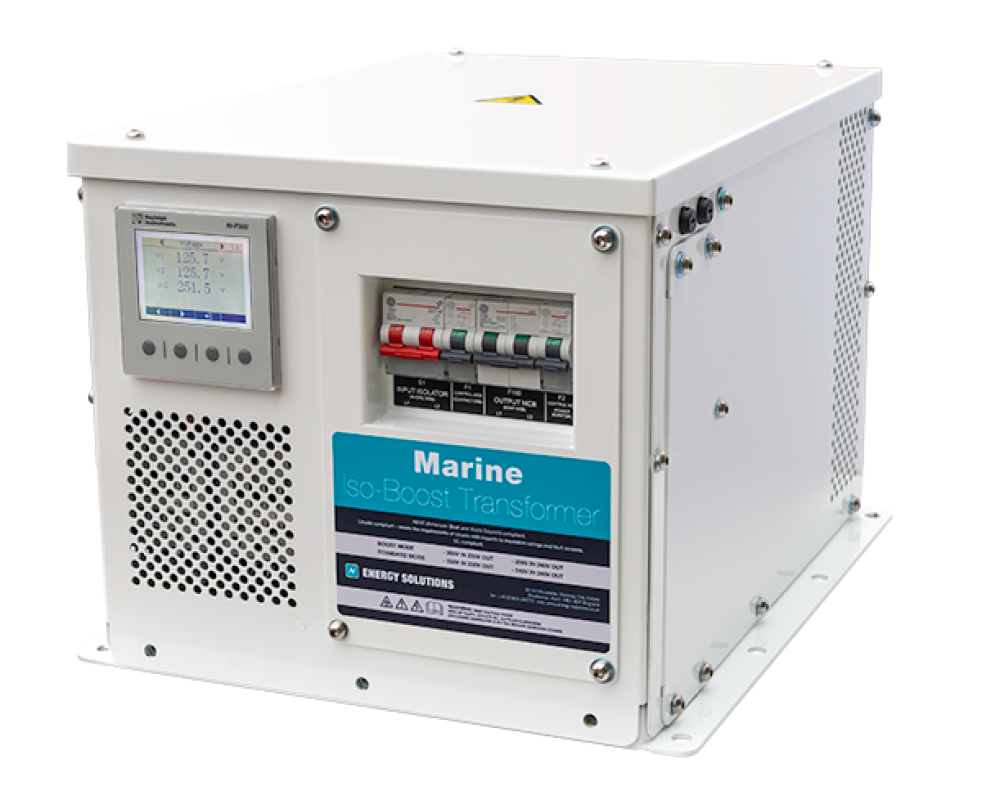
Marine Iso-Boost Transformers
The Energy Solutions IsoBoost transformer provides a cost effective and reliable solution to isolate and manage a shore line. It provides all of the features of a normal isolation transformer, as well as providing a boost function to manage the volt drop on heavily loaded shore lines, or to cope with a 208V (phase to phase) supply. On startup, the isolation transformer automatically soft starts the transformer to prevent inrush from tripping the supply breaker. If the voltage is in range, it operates in 1:1 mode, so that the output voltage matches the input voltage. If the supply voltage drops below 215V, it automatically switches into boost mode, effectively raising the output voltage by around 10%. If the supply voltage recovers, the IsoBoost automatically switches back to 1:1 operation.
Our Marine IsoBoost Transformers are an exact fit and form replacement for Charles Industries™ Isoboost transformers.
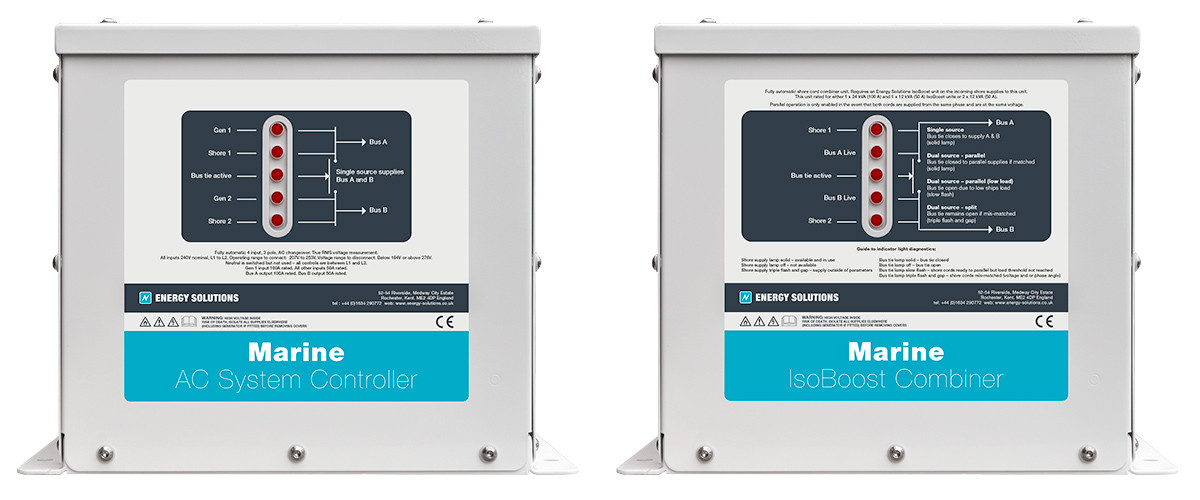
AC System Controller and IsoBoost Combiner
The AC System Controller and IsoBoost Combiner allow enhanced system functionality when more than one IsoBoost is required.
The AC System Controller provides a simple, automatic AC source selection and suits a wide variety of power supply configurations.
The IsoBoost Combiner allows two shore cords to be combined from the Energy Solutions IsoBoost/Marine Isolation Transformer range, allowing loads to be applied evenly across both cords.
For full details on the entire Marine IsoBoost Transformer range download the brochure;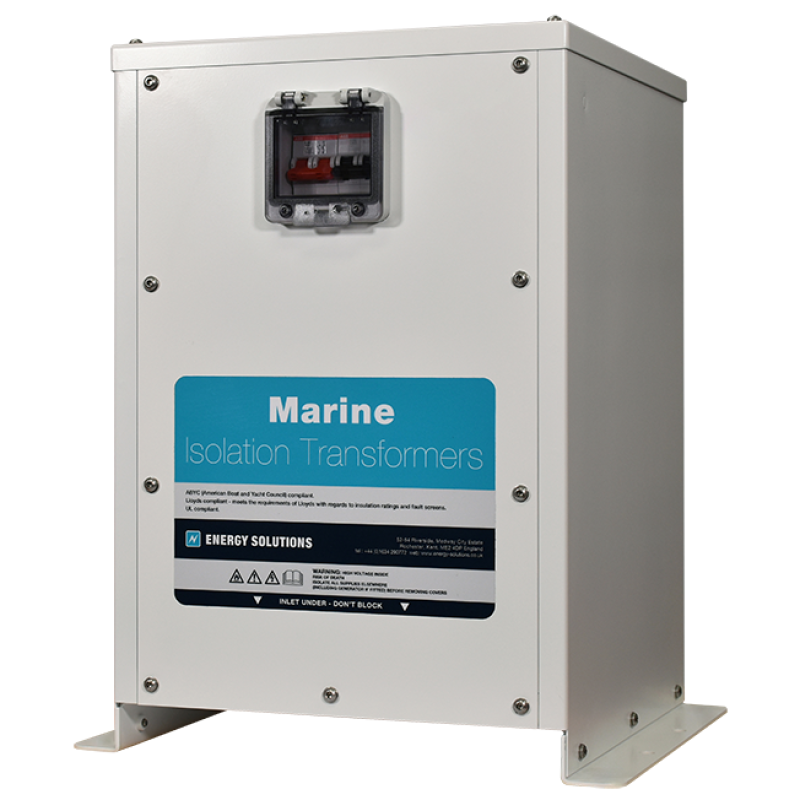
Marine Iso Transformers
We offer a range of single and three phase isolation transformers of all capacities. Our standard range of isolation transformers offer the following features:
- Complete range - 10, 16, 32, 50, 63 & 100 amp single phase shore capacities at 230V
- Dedicated output - our larger transformers come configured to provide either 120-0-120V 4 wire USA output or 0-230V 3 wire Euro output.
- ABYC compliant - all transformers are built with a screen between primary and secondary windings capable of carrying twice the full load current of the transformer. This exceeds the requirements of ABYC E-8.20.1 by 100%.
- Lloyds compliant - all transformers are built to comply with the requirements of the LRS.
- Resin coated - all transformers are protected with a UL approved vacuum impregnated polyester varnish.
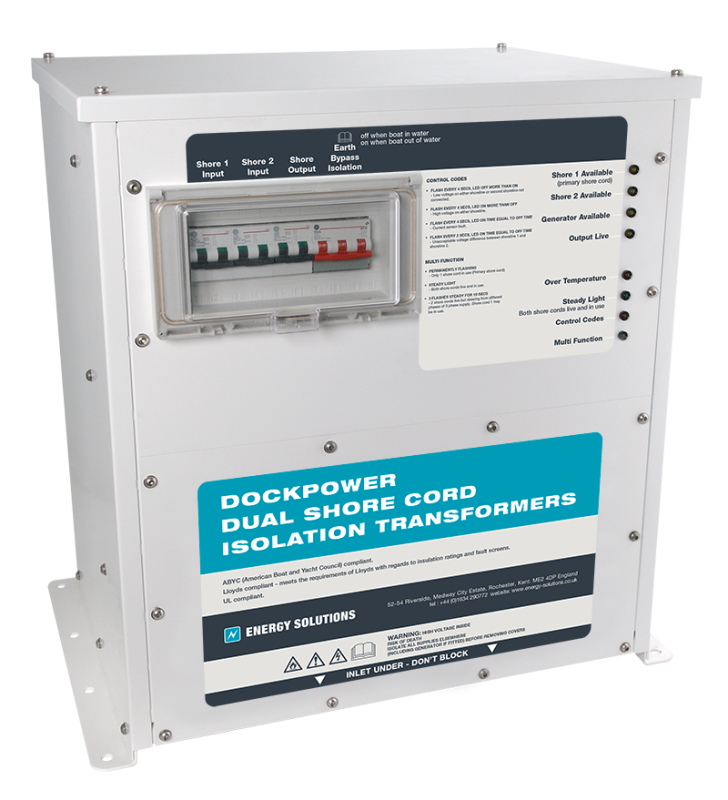
ES DockPower - Dual Shore Cord Isolation Transformer
The demand for shore power means that larger motor yachts often have dual 32A or even dual 63A shore power sockets. This requires the boat’s internal AC circuitry to be split into two entirely separate groups - normally air conditioning and domestic. But if one circuit tries to pull more than the maximum rating there’s nothing to be done to stop the dockside load circuit breaker tripping, even if the other cord has plenty of capacity left.
The DockPower isolation transformer range from Energy Solutions solves this problem by allowing boat owners to bring two shorepower leads onto a boat and combine them into a single supply to feed all the boat’s loads. The two cords are loaded equally which ensures you get the maximum amount of power on board. Suitable for a range of vessels from large sailing boats to mid-sized motor yachts, DockPower provides an important solution to their specific power requirements.
Options and Configurations
Standard Insulation
The standard transformer is protected by being immersed in a resin bath. This is done under a vacuum to ensure total coverage. This protects the transformer from air borne moisture and normal corrosion.
Double Dipped Insulation Option
In addition to the standard insulation the transformer receives a second water proof coating. The take off ends of the coil windings are also sealed to prevent water ingress. This additional insulation is suited to transformers that maybe subjected to water contact.
Soft Start
When first connected to the shore supply the hull isolation transformer will draw a very high initial current. This can often trip the shore supply circuit breaker. Energy Solutions are able to install a soft start on the input of the transformer to greatly reduce the inrush current.
Input Configuration
Most of the smaller, single phase, transformer range is offered with a dual wound primary. This allows the transformer to be connected to both 110 volt and 230 volt shore power supplies.
Most three phase transformers are supplied as a Delta input (no neutral connected).
Output Configuration
The output configuration of the transformer can be requested as:
- 230 volt for European systems
- 240/120 volt for American systems
- 208 volts three phase for USA spec boats
- 400 volts three phase for Europeans spec boat
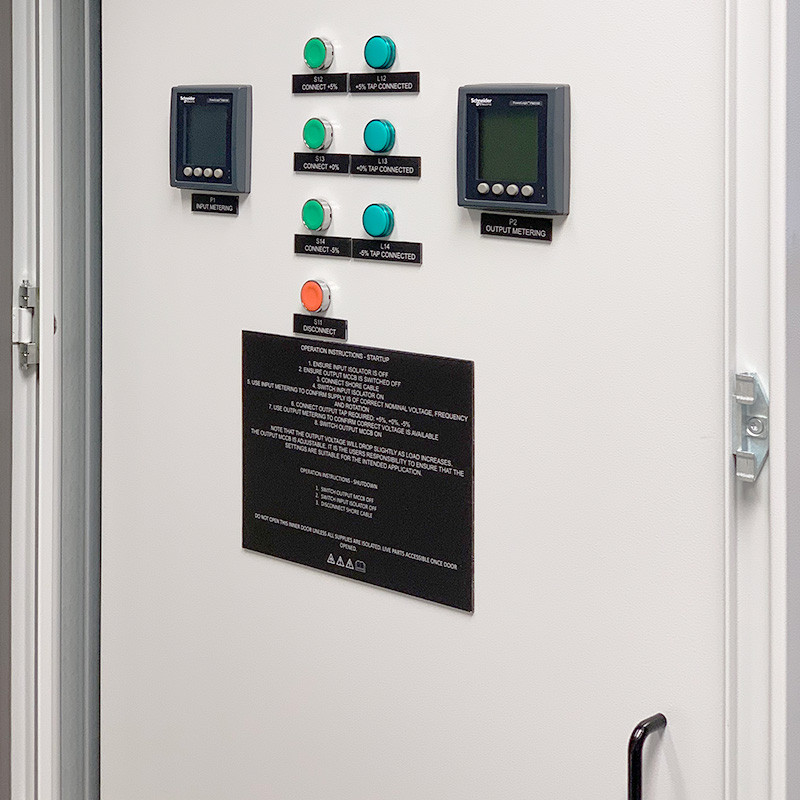
Dockside Transformers
We can also design and build bespoke dockside isolation transformers for use in marinas and boatyards enabling ships with no isolation transformer on board to safely ‘cold iron’.
Available sizes from 15kVA to 250kVA with special options such as IP54, multi-tapped outputs, integral protection and control gear.
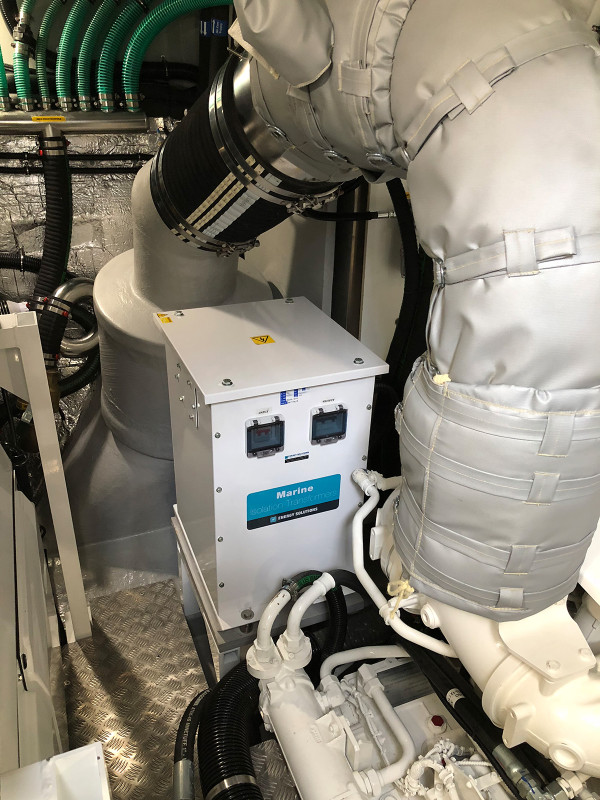
Custom Transformers
Most of the Energy Solutions range of marine isolation transformers have dual input voltages (120 and 240 volt). This is of particular use on long distance cruising boats that may want to use 110 volt supplies in Caribbean, USA Etc.
They also help to protect swimmers against the risk of electrocution. This is a particular risk on fresh water moorings.
Energy Solutions are able to supply specific transformers for individual applications. These may be single or three phase. We have supplied transformers up to 250kVA.
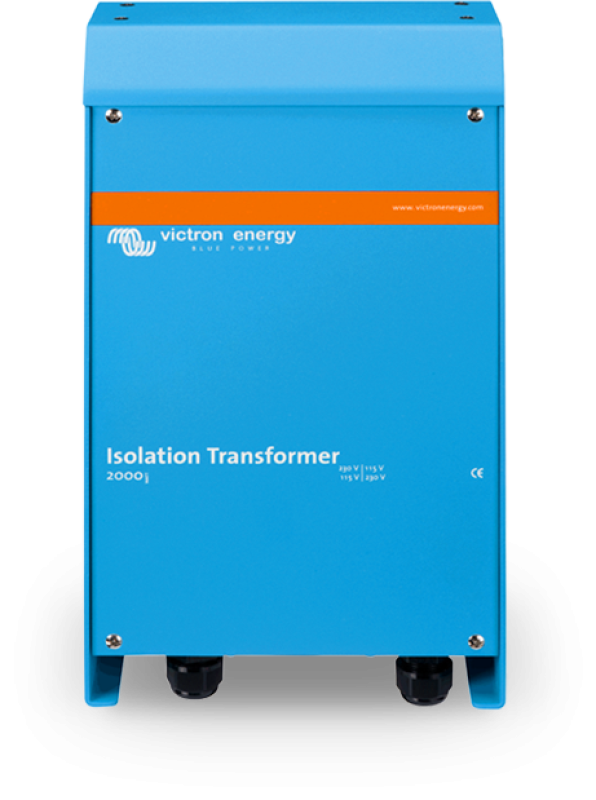
Victron Isolation Transformers & Galvanic Isolators
2000VA / 3600VA / 7000VA
For smaller applications we can also provide the Victron range of isolation transformers. This range is indispensable in professional marine energy systems. It prevents electrolytic corrosion and above all serves as a device to guarantee a safe electric system. Toroidal wound technology for quietness and high efficiency. Soft start circuitry will ensure that the shore circuit breaker will not trip when plugged in.
Galvanic Isolators
Galvanic Isolators are a low cost solution to prevent galvanic corrosion that occurs on boats with electric power feeds.
About Us
Manufactured In the UK
We design and manufacture a wide range of products in our factory in the UK. We have invested in state of the art cable processing machines to allow us to automate many aspects of our production, guaranteeing quality and consistency. Our engineering department use advanced mechanical and electrical design tools to drive this process, and we use computerised testing machines to speed up loom construction and validation. We also have in-house facilities to laser cut and engrave control panels, along with 3D printing for prototyping components. None of this manufacturing would be possible without a skilled team of staff, with years of experience in complex builds.
Partners
We work with leading international manufacturers and distribute their products in order to supply our customers with a complete electrical power, monitoring and control solution. We work with some of the biggest names in each market sector and have established ourselves as a key supplier bringing new ideas and technical updates on a continual basis.
Support
During your project, Energy Solutions will be with you every step of the way, from initial consultation to final implementation. Our engineering team will provide comprehensive drawing packages, both 2D and 3D as appropriate, and will assist during commissioning phases. Post-project, our service team will take over to provide ongoing support in the field.
Sign up to our mailing list
Keep up to date with the latest news and offers.
Submitting your details indicates that you have read and agree to our privacy policy and cookie policy. You can unsubscribe from our emails by using the link at the bottom of all emails we send.